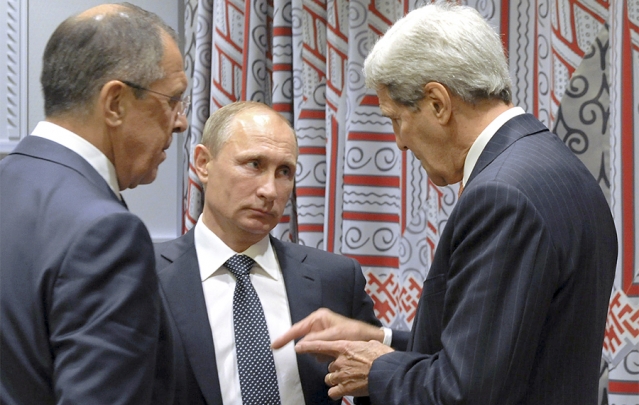New Syria Talks Highlight Russian Ascendance, U.S. Ambivalence
Anna Borshchevskaya and James F. Jeffrey/The Washington Institute/October 22/15
Without stronger American military efforts to hurt ISIS and help the rebels, the Vienna summit has little chance of preventing Moscow from taking the driver’s seat in Syria.
This week, President Bashar al-Assad made an unannounced trip to Moscow on the eve of October 23 talks in Vienna between Russian foreign minister Sergei Lavrov, Secretary of State John Kerry, and their Turkish and Saudi counterparts, who are meeting to discuss the Syrian conflict. In his welcoming remarks to Assad, President Vladimir Putin linked Moscow’s political and military strategies: “On the question of a settlement in Syria, our position is that positive results in military operations will lay the basis for working out a long-term settlement, based on a political process that involves all political forces, ethnic groups, and religious groups.”
Russia’s motivations have not changed: in a zero-sum approach to diplomacy, Putin has consistently taken advantage of Western ambivalence on Syria since the uprising began in 2011. The vacuum created by this indecision allowed Putin to insert himself into the peace discussions and advance a self-serving agenda: namely, keeping Assad in power, positioning the Kremlin as an indispensable global player, and distracting the Russian public from domestic problems. After the 2012 and 2014 international peace talks in Geneva failed to produce a resolution, Moscow hosted its own “intra-Syrian” talks in January and April 2015. Those meetings did not advance a true peace settlement either. Rather, they allowed the Kremlin to engage factions that do not demand Assad’s departure while reinforcing the notion that he is an indispensable actor in battling “terrorists” — which Moscow and Damascus define as any armed individual who opposes the regime.
Putin is confident in making such moves because he believes that Western policymakers will not stand by their words, a lesson learned when Washington failed to enforce its redline on chemical weapons use in Syria, welcomed Moscow’s 2013 offer to disarm the regime, and tacitly accepted Assad as part of the peace process despite previous statements that he should “step aside.” Similarly, since Moscow launched its military intervention last month, Russian forces in Syria have violated Turkish airspace multiple times and reportedly shadowed a U.S. drone without consequence — Putin tested the West and saw once again that it will reply with little besides angry rhetoric and symbolic moves.
Putin’s Partition Plan for Syria
By HUSSEIN IBISH/New York Times
OCTOBER 19, 2015
WASHINGTON — Taking advantage of the paralysis of American policy in Syria, Russia’s dramatic escalation of military activity in that country seeks to reorder the strategic landscape of the Middle East.
Few appear to grasp the full scope of what Russia’s president, Vladimir V. Putin, is attempting. This is partly because, in theory, this should be beyond Russia’s capabilities. But Mr. Putin cannily senses an opportunity, at the very least, to restore Russia to the role in the Middle East that it lost in the 1970s.
Russia’s intervention anticipates a resolution of the Syrian conflict through de facto partition. The Reuters news agency reports that, months ago, Iran proposed the joint offensive, now underway, to save the dictatorship of President Bashar al-Assad from imminent collapse. Maj. Gen. Qassem Soleimani, commander of the Islamic Revolutionary Guards Corps’ elite Quds Force, is depicted poring over maps of Syria with Russian officials in the Kremlin.
Russian firepower is aimed at securing the larger, western part of the rump Syrian state that is still controlled by Mr. Assad — in particular the air and naval bases near Latakia and Tartus. And aside from forays into northern trouble spots like Aleppo, Iranian and Hezbollah forces will mostly concentrate on the lower half of this strip, which runs from the Lebanese border through Qalamoun, up to Damascus, and from there to the port cities and coastal heartland of the Alawites, the Syrian Shiite sect loyal to Mr. Assad.
For all of the talk of combating the Islamic State, Russia’s real aim is to push back rebel groups and secure this ministate. Given what Mr. Assad’s allies are willing to do to salvage this “Little Syria” — compared with the limited intervention being considered by Mr. Putin’s international antagonists — this is probably an achievable goal.
Such a partition of Syria would leave other parts of the country in the hands of nationalist and Islamist rebels, a Kurdish area in the north, perhaps some smaller enclaves and, most ominously, the “caliphate” of the Islamic State in the north and east. Despite Kremlin propaganda, the Islamic State is already among the biggest winners from the Russian intervention.
At the end of last week, for example, the group took advantage of Russian airstrikes, some 90 percent of which have reportedly targeted other rebel groups, and captured several villages near Aleppo. The militants also killed some of Iran’s most senior commanders in Syria, including Brig. Gen. Hossein Hamedani. These advances are realizing Mr. Assad’s goal of making the choice for both Syrians and the world at large appear to be between him and the jihadists.
Russia’s unspoken but unmistakable message is that Moscow is trying one— and perhaps the only— way of ending the conflict by means of a Lebanese-style segregation of Syria into zones controlled by rival militias. To Washington’s perennial concern in any Middle Eastern imbroglio, “Tell me how this ends,” Moscow responds: The Syrian conflict will be “resolved” on Russia’s terms, even if Mr. Assad proves dispensable to the Kremlin in the long run.
Meanwhile, the Obama administration’s desire to see the conflict end without actually doing anything itself means that, as Bloomberg View suggested recently, there is a group of senior American officials prepared to go along with the Russian plan. After all, America’s own policy in Syria has rapidly moved from tragedy to farce. The latest fiasco was the cancellation of the $500 million military training program for anti-Islamic State rebels that produced barely a handful of fighters on the ground.
So if Moscow has a policy, and Washington doesn’t, why not just support that?
Beyond the fact that it’s absurd to hope that Mr. Putin’s approach is likely to benefit American interests, giving way to Russia’s policy would, in effect, entail abandoning the fight against the Islamic State in Syria. And the militants cannot be effectively countered in Iraq alone. So what this final, ignominious capitulation would really mean is that not only would Mr. Assad (or some Russian-appointed successor) menace Syrians for the foreseeable future, but so too would the Islamic State.
No wonder Gen. John R. Allen, America’s envoy to the international coalition against the Islamic State, recently announced his resignation. Being in charge of a farce is bad enough; no one can accept being the front for a fraud.
Even worse, viewed through a broader regional framework, American acquiescence to this Russian initiative would ultimately mean an accommodation with a major reshaping of the strategic order in the Middle East. Moscow is clearly trying to accomplish the creation of a powerful alliance with Iran, Iraq, Hezbollah, “Little Syria” and others. To secure this new compact, Russia is willing to risk not only confrontation with the West, but also its recently improved relations with other regional powers like Turkey and Saudi Arabia.
There’s no good reason Washington should go along with any of this. Russia is manifestly less powerful militarily, economically and diplomatically than the United States. But it’s no longer a matter of capabilities; it’s become a matter of will. On paper, Russia is in no position to barge into the Middle East and throw its weight around. But after the interference in Ukraine, the annexation of Crimea and the Syrian chemical weapons debacle, Mr. Putin correctly judged that nobody would stop him.
Mr. Putin is canny enough to know that he is already overstretched, faces potential quagmires and has core differences with putative allies like Iran. So, at any given moment, he’ll be ready to pocket his gains and do a deal with the Americans — from an already advantageous position.
The remaining question is: How far will he be allowed to go? At the moment, the astonishing answer appears to be: all the way.
Hussein Ibish is a senior resident scholar at the Arab Gulf States Institute in Washington and a contributing opinion writer.
Putin’s meeting with Assad this week is a further testament to his confidence that he can force the West to accept his position. According to Russia’s TASS News Agency, the parliament’s upper house speaker Valentina Matviyenko called on “all interested countries to join the dialogue between Russia and Syria” after the meeting, highlighting Moscow’s perceived position as the leader in resolving the crisis.
In this context, the October 23 meeting in Vienna represents a defeat for traditional U.S. policy in the region since 1973, under which America and its allies have borne primary responsibility for countering threats to peace. This defeat is the inexorable result of the Obama administration’s reluctance to use necessary military force in Syria — first in withholding threatened strikes against Assad when he used chemical weapons against his own people, and then in limiting strikes against ISIS despite vowing to “destroy” the group. It simultaneously reflects the emergence of not only a Russian military operational presence in the region, but also a budding Russian alliance with Iran. The only good news is that the Assad regime will not be at the table in Vienna — though even that is tempered by Assad’s surprise trip to Moscow.
In all likelihood, Friday’s talks will have one of two outcomes. The first is American and Saudi acquiescence to an “Assad stays for the moment” strategy in order to focus on fighting ISIS. Such an approach would reflect the military steps Russia and Iran are taking in Syria with their allies, as well as continued unwillingness in Washington — and thus the entire Arab-Turkish anti-Assad coalition — to challenge Moscow and Tehran. If this scenario comes to pass, the U.S. and Saudi policy of seeking Assad’s ouster would be left in shreds, and he would remain in power indefinitely to complete the depopulation of much of his country.
Alternatively, Washington and Riyadh might refuse to formally endorse Assad and play second fiddle to Moscow and Tehran’s so-called “anti-ISIS” campaign, yet still offer some flexibility on the timing of Assad’s departure. While not as abject a surrender as the first possibility, this position would amount to only temporary face saving unless it were backed by much more aggressive U.S. and Saudi support for those fighting Assad, and a much more effective, rapid U.S.-led military campaign against ISIS. Barring that, Russia and Iran are unlikely to feel any pressure.
In either scenario, it is far from clear whether any ceasefire or transition agreements emerging from the Vienna talks could be implemented on the battlefield. U.S. credibility with armed rebel factions is very low, and their regional backers are unlikely to back off whether Russia is bombing or not. It also remains doubtful that Russia could deliver Assad to anything but a Potemkin political process of the sort that the opposition has already rejected multiple times, even while losing on the battlefield. Therefore, the likeliest scenario is that no matter what happens in Vienna, the war’s diplomatic and military tracks will continue to head in two different directions.
**Anna Borshchevskaya is the Ira Weiner Fellow at The Washington Institute. James Jeffrey is the Institute’s Philip Solondz Distinguished Fellow.




















